| Listing 1 - 10 of 17 | << page >> |
Sort by
|
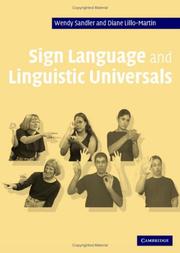
ISBN: 9780521482486 9780521483957 0521482488 0521483956 9781139163910 1139163914 Year: 2006 Publisher: Cambridge : Cambridge University Press,
Abstract | Keywords | Export | Availability | Bookmark
 Loading...
Loading...Choose an application
- Reference Manager
- EndNote
- RefWorks (Direct export to RefWorks)
Sign languages are of great interest to linguists, because while they are the product of the same brain, their physical transmission differs greatly from that of spoken languages. In this 2006 study, Wendy Sandler and Diane Lillo-Martin compare sign languages with spoken languages, in order to seek the universal properties they share. Drawing on general linguistic theory, they describe and analyze sign language structure, showing linguistic universals in the phonology, morphology, and syntax of sign language, while also revealing non-universal aspects of its structure that must be attributed to its physical transmission system. No prior background in sign language linguistics is assumed, and numerous pictures are provided to make descriptions of signs and facial expressions accessible to readers. Engaging and informative, Sign Language and Linguistic Universals will be invaluable to linguists, psychologists, and all those interested in sign languages, linguistic theory and the universal properties of human languages.
Linguistics --- Sign language --- Semiotics --- Alphabet dactylologique --- Alphabet des sourds --- Communication gestuelle --- Dactylologie --- Deaf -- Sign language --- Doven -- Gebarentaal --- Gestes [Langage par ] --- Langage des signes --- Langage des signes pour les sourds --- Langage des sourds --- Langage gestuel --- Langage gestuel des sourds --- Langage mimique --- Langage par gestes --- Langage par signes pour les sourds --- Langue des signes --- Langue des sourds --- Mimique --- Signes [Langage par ] --- Sourds -- Langage par signes --- Sourds -- Langue des signes --- #KVHA:Gebarentaal --- Sign language. --- #KVHA:Taalkunde --- Linguistic universals --- Deaf --- Gesture language --- Language and languages --- Gesture --- Signs and symbols --- Universals (Linguistics) --- Typology (Linguistics) --- Universals --- Linguistic universals. --- Universals (Linguistics). --- Arts and Humanities --- Language & Linguistics --- Langage par signes --- Universaux (linguistique)
Book
ISBN: 2700800605 9782700800609 Year: 1978 Volume: 46 7 Publisher: Paris : J.-B. Baillière,
Abstract | Keywords | Export | Availability | Bookmark
 Loading...
Loading...Choose an application
- Reference Manager
- EndNote
- RefWorks (Direct export to RefWorks)
Deaf --- Deafness --- Sourds --- Surdité --- Education --- Psychological aspects --- Aspect psychologique --- Surdité --- Deaf - Education --- Deafness - Psychological aspects --- Deaf people --- Education.
Book
ISBN: 1283349167 9786613349163 0199909458 9780199909452 9781283349161 9780195389753 0195389751 661334916X Year: 2012 Publisher: New York : Oxford University Press,
Abstract | Keywords | Export | Availability | Bookmark
 Loading...
Loading...Choose an application
- Reference Manager
- EndNote
- RefWorks (Direct export to RefWorks)
How can parents and teachers most effectively support the language development and academic success of deaf and hard-of-hearing children? Will using sign language interfere with learning spoken language? Should deaf children be placed in classrooms with hearing children? Are traditional methods of teaching subjects such as reading and math to hearing children appropriate for deaf learners? As many parents and teachers will attest, questions like these have no easy answers, and it can be difficult for caring adults to separate science from politics and fact from opinion in order to make informed
Deaf children --- Deaf --- Parents of deaf children. --- Deafblind children's parents --- Deafblind children --- Education of the deaf --- Means of communication. --- Language. --- Education. --- Surdité. --- Parents of deaf children --- Enfants sourds. --- Means of communication --- Language --- Education --- Enfants sourds --- Sourds --- Communication. --- Éducation. --- Deaf people
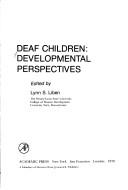
ISBN: 0124479502 1322301557 1483218554 Year: 1978 Publisher: New York Academic Press
Abstract | Keywords | Export | Availability | Bookmark
 Loading...
Loading...Choose an application
- Reference Manager
- EndNote
- RefWorks (Direct export to RefWorks)
Psycholinguistics --- Deafness --- Deaf children --- Enfants sourds --- In infancy and childhood --- Rehabilitation --- Children, Deaf --- Deafness in children --- Hearing impaired children --- Patients --- In infancy and childhood. --- rehabilitation.
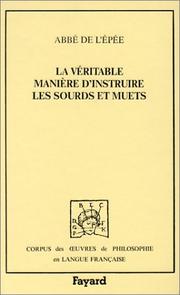
ISBN: 2213014760 9782213014760 Year: 1984 Volume: 4 Publisher: Paris Fayard
Abstract | Keywords | Export | Availability | Bookmark
 Loading...
Loading...Choose an application
- Reference Manager
- EndNote
- RefWorks (Direct export to RefWorks)
Psycholinguistics --- Deaf --- Sourds --- Education --- Early works to 1800 --- Ouvrages avant 1800 --- -Deaf-mutes --- Deaf people --- Deafness --- Hearing impaired --- Deafblind people --- -Early works to 1800 --- Patients --- -Education --- Deaf-mutes --- Education&delete& --- Deaf - Education - Early works to 1800 --- Early works to 1800.

ISBN: 2222021979 9782222021971 Year: 2004 Volume: 42 Publisher: Paris : CNRS (Centre national de la recherche scientifique),
Abstract | Keywords | Export | Availability | Bookmark
 Loading...
Loading...Choose an application
- Reference Manager
- EndNote
- RefWorks (Direct export to RefWorks)
-Deaf-mutes --- Deaf --- Gesture language --- Speech-reading --- Speechreading --- Communication --- Education of the deaf --- Education --- Means of communication --- Speech --- Sourds --- Moyens de communication --- Deaf - Education --- Deaf - Means of communication --- Deaf people --- Education. --- Means of communication.
Periodical
ISSN: 0002726X 15430375 Year: 1847 Publisher: Silver Spring American annals of the deaf
Abstract | Keywords | Export | Availability | Bookmark
 Loading...
Loading...Choose an application
- Reference Manager
- EndNote
- RefWorks (Direct export to RefWorks)
personen met een auditieve beperking --- Otorhinolaryngology --- Deaf --- Sourds --- Periodicals --- Study and teaching --- Périodiques --- Etude et enseignement --- Deaf. --- #A50211 --- Disability Studies & Assistance --- Rehabilitation --- Social Sciences --- Sociology. --- Law --- Crime, Criminology and Law Enforcement --- Sociology --- Social Sciences. --- Surdité --- Éducation --- Périodiques --- EBSCOCMMC-E EJCOMMU EJLANGU EPUB-ALPHA-A EPUB-PER-FT --- Persons With Hearing Impairments. --- Deafness. --- Sords --- Educació especial --- Deaf people --- Sords. --- Educació especial.
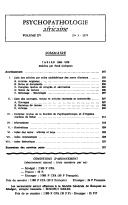
ISBN: 2222022746 9782222022749 Year: 1978 Volume: 43 Publisher: Paris Centre national de la recherche scientifique
Abstract | Keywords | Export | Availability | Bookmark
 Loading...
Loading...Choose an application
- Reference Manager
- EndNote
- RefWorks (Direct export to RefWorks)
Psycholinguistics --- Sign language --- Deaf --- Langage par signes --- Sourds --- Syntax --- Means of communication --- Syntaxe --- Moyens de communication --- -Deaf --- -Deaf-mutes --- Deaf people --- Deafness --- Hearing impaired --- Deafblind people --- Gesture language --- Language and languages --- Gesture --- Signs and symbols --- Patients --- -Syntax --- Deaf-mutes --- Speech-reading --- Speechreading --- Communication --- Education --- Speech --- Sign language - Syntax --- Deaf - Means of communication --- Syntax. --- Means of communication.
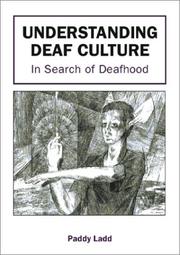
ISBN: 9786610827954 1280827955 9781853595471 1853595470 9781847696892 1847696899 9781853595479 1853595462 9781853595462 1853595454 9781853595455 9781280827952 Year: 2003 Publisher: Bristol Blue Ridge Summit
Abstract | Keywords | Export | Availability | Bookmark
 Loading...
Loading...Choose an application
- Reference Manager
- EndNote
- RefWorks (Direct export to RefWorks)
This book presents a ‘Traveller’s Guide’ to Deaf Culture, starting from the premise that Deaf cultures have an important contribution to make to other academic disciplines, and human lives in general. Within and outside Deaf communities, there is a need for an account of the new concept of Deaf culture, which enables readers to assess its place alongside work on other minority cultures and multilingual discourses. The book aims to assess the concepts of culture, on their own terms and in their many guises and to apply these to Deaf communities. The author illustrates the pitfalls which have been created for those communities by the medical concept of ‘deafness’ and contrasts this with his new concept of “Deafhood”, a process by which every Deaf child, family and adult implicitly explains their existence in the world to themselves and each other.
Deaf. --- Deaf --- Subculture. --- Sociology of disability. --- Deaf-mutes --- Deaf people --- Deafness --- Hearing impaired --- Deafblind people --- Disabilities --- Sociology of disablement --- Sociology of impairment --- People with disabilities --- Subcultures --- Culture --- Ethnopsychology --- Social groups --- Counterculture --- Patients --- Sociological aspects --- Sociology of disability --- Subculture --- #KVHA:Dovencultuur --- #KVHA:Taalkunde; Gebarentaal --- Handicap --- Sourds. --- Surdité. --- Sociologie --- Surdité.
Periodical
ISSN: 03021475 Publisher: Silver Spring, Md
Abstract | Keywords | Export | Availability | Bookmark
 Loading...
Loading...Choose an application
- Reference Manager
- EndNote
- RefWorks (Direct export to RefWorks)
Linguistics --- Sign language --- Semiotics --- Deaf --- Langage par signes --- Sourds --- Periodicals --- Means of communication --- Périodiques --- Moyens de communication --- Manual Communication --- Arts and Humanities --- Language & Linguistics --- Literature --- Anthropology --- Disability Studies & Assistance --- Social Sciences --- Law --- Crime, Criminology and Law Enforcement --- Sign language. --- Means of communication. --- Arts and Humanities. --- Disability Studies & Assistance. --- Social Sciences. --- Périodiques --- EBSCOCMMC-E EJCOMMU EJLANGU EPUB-ALPHA-S EPUB-PER-FT --- Deaf people --- Periodicals.
| Listing 1 - 10 of 17 | << page >> |
Sort by
|

 Search
Search Feedback
Feedback About UniCat
About UniCat  Help
Help News
News